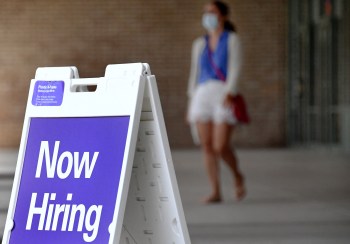
Measuring immigrants’ impact on innovation

Most economists, business leaders and heads of organizations will emphasize the critical role of innovation and technological advances. In the U.S., the close ties between innovation and skilled immigration are well known, as one study outlines.
Yet it turns out that the extent to which innovation in the United States depends on these highly skilled immigrants is greatly underappreciated, according to Senior Economics Contributor Chris Farrell.
“If you’re having skilled immigrants coming in here and bringing in their ideas, and they’re working with innovators who are native-born, everyone sees the benefit, particularly the US economy,” Farrell said in an interview with Marketplace’s David Brancaccio.
The following is an edited transcript of their conversation.
David Brancaccio: Immigration. It’s a hot-button political issue perennially. But the economic gains from attracting skilled immigrants to the U.S. are quite well documented.
Chris Farrell: It is. But I still find the numbers striking. I mean, let me just list a few telling figures. Foreign-born newcomers have been awarded 38% of Nobel Prizes won by Americans in chemistry, medicine, in physics. Between 2020-21 immigrants accounted for almost 1/4 of the STEM workforce — STEM stands for Science, Technology, Engineering and Math. High-tech hotspots like Silicon Valley and Boston’s Route 128 rely on immigrant scientists, engineers, and entrepreneurs.
Brancaccio: Yet those numbers, and in my own reporting, I’ve seen many other datasets with a similar message. You think they still don’t tend to capture the total contribution that immigrants make to innovation in the U.S.?
Farrell: Not even close. At least that’s my reaction to a recent study by five economists: The Contribution of High-Skilled Immigrants to Innovation in the United States. So these economists tap into and stitch together a number of data sources to get a more comprehensive and more nuanced understanding of the contributions of skilled immigrants to innovation. So to give you one example, they find that 16% of U.S.-based inventors, between 1990 and 2016, were immigrants who came to the U.S. when they were 20 years or older. Yet these immigrant inventors have produced roughly 23% of all innovations, and that’s measured by number of patents, patent citations, and the economic value of these patents.
Brancaccio: But you do have U.S.-born people with skills worrying that new immigrants can bring down compensation in the field.
Farrell: And I think that’s been a genuine concern. But what I took away from this study, David, is that it’s not a zero-sum game. So if you’re having skilled immigrants coming in here and bringing in their ideas, and they’re working with innovators who are native-born, everyone sees the benefit, particularly the U.S. economy. And compensation is important, but so is innovation. That’s where we get our higher incomes from going forward.
Brancaccio: But what accounts for the greater productivity among immigrant innovators, do you think?
Farrell: So several factors may be at work. I mean, for one thing, it looks like immigrants choose to live in innovation hubs, and were seen to focus on working at technology’s frontier. But what really struck me was their international ties contribute to the importation — the diffusion — of ideas across borders, as well as cross-border collaborations. So if you take into account these idea bridges, these innovation bridges, built between the U.S. and the home countries of immigrants as well as other measures, the economists calculate that skilled immigrants are responsible for more than one third of aggregate innovation in the U.S., and that’s a stunning number.
There’s a lot happening in the world. Through it all, Marketplace is here for you.
You rely on Marketplace to break down the world’s events and tell you how it affects you in a fact-based, approachable way. We rely on your financial support to keep making that possible.
Your donation today powers the independent journalism that you rely on. For just $5/month, you can help sustain Marketplace so we can keep reporting on the things that matter to you.

















